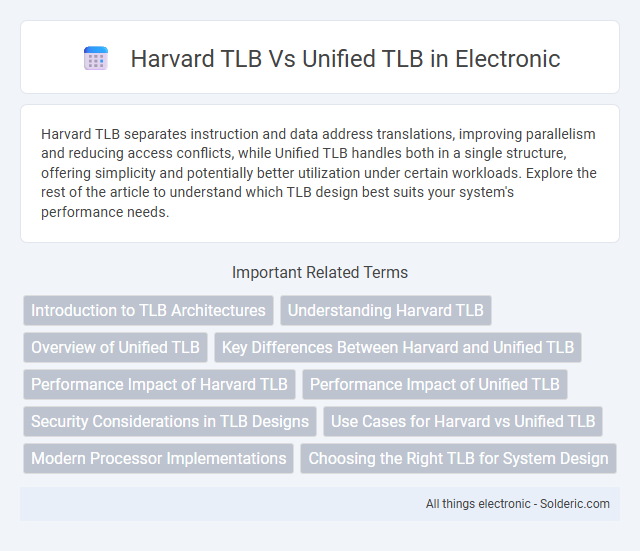Harvard TLB separates instruction and data address translations, improving parallelism and reducing access conflicts, while Unified TLB handles both in a single structure, offering simplicity and potentially better utilization under certain workloads. Explore the rest of the article to understand which TLB design best suits your system's performance needs.
Comparison Table
| Feature | Harvard TLB | Unified TLB |
|---|---|---|
| Definition | Separate Translation Lookaside Buffers for Instruction and Data | Single TLB shared for both Instruction and Data |
| Design | Split-cache approach | Combined-cache approach |
| Access Speed | Faster access due to concurrent lookup for instructions and data | Single lookup may cause serialization and slightly slower access |
| Complexity | Higher hardware complexity and area due to duplicated TLBs | Simpler hardware design with one TLB |
| Hit Rate | Potentially lower due to limited TLB entries per type | Potentially higher by utilizing TLB entries flexibly |
| Power Consumption | Typically higher due to multiple TLB structures | Lower overall power requirement |
| Use Case | Common in Harvard architecture CPUs and embedded systems | Widely used in general-purpose and modern processors |
Introduction to TLB Architectures
Harvard TLB architecture separates instruction and data translation lookaside buffers, allowing simultaneous parallel access and reducing contention in memory address translation. Unified TLB combines both instruction and data entries into a single buffer, optimizing overall utilization but potentially increasing access latency due to contention. These TLB architectures critically impact processor performance by balancing parallelism and resource efficiency in virtual memory address translation.
Understanding Harvard TLB
Harvard TLB architecture separates instruction and data translation lookaside buffers, allowing simultaneous parallel access that enhances memory access speed and reduces bottlenecks during CPU operations. Unlike Unified TLB, which combines both instruction and data caches into a single structure, Harvard TLB improves efficiency by isolating translation tasks, leading to faster address resolution and better pipeline performance. Understanding Harvard TLB helps you optimize system design for workloads requiring high bandwidth and low latency in instruction and data fetching.
Overview of Unified TLB
Unified TLB combines both instruction and data translation lookaside buffers into a single cache, optimizing memory address translation efficiency. This design reduces hardware complexity and improves hit rates by sharing entries for both instruction and data page tables. Your system benefits from faster virtual-to-physical address translation and simplified TLB management compared to the Harvard TLB, which maintains separate TLBs for instructions and data.
Key Differences Between Harvard and Unified TLB
Harvard TLB separates instruction and data address translation, maintaining distinct translation lookaside buffers for each memory type, which reduces contention and improves parallelism in accessing instruction and data caches. Unified TLB consolidates address translation for both instruction and data accesses into a single buffer, simplifying management but potentially increasing access conflicts. Harvard TLB typically offers lower latency in mixed instruction-data workloads, while Unified TLB benefits system simplicity and memory utilization efficiency.
Performance Impact of Harvard TLB
Harvard TLB separates instruction and data address translation, reducing contention and improving access parallelism compared to a Unified TLB. This separation can significantly enhance Your processor's performance by minimizing TLB miss penalties during simultaneous instruction fetch and data access. The increased efficiency in address translation leads to lower latency and higher instruction throughput in Harvard TLB architectures.
Performance Impact of Unified TLB
Unified TLB combines separate instruction and data TLBs into a single structure, reducing the total number of TLB misses and improving hit rates by leveraging shared entries. This consolidation enhances memory access efficiency and lowers latency, directly boosting your system's overall performance by minimizing costly page table walks. Unified TLBs offer a streamlined approach that better utilizes cache resources compared to Harvard TLB designs with separate instruction and data translation lookaside buffers.
Security Considerations in TLB Designs
Harvard TLB separates instruction and data translation lookaside buffers, enhancing security by isolating execution and data accesses, reducing side-channel attack risks. Unified TLB combines both instruction and data mappings, increasing efficiency but potentially exposing more attack vectors through shared entries. Security-sensitive systems prefer Harvard TLB to enforce stricter access controls and reduce the risk of TLB poisoning exploits.
Use Cases for Harvard vs Unified TLB
Harvard TLB is ideal for systems that separate instruction and data caches, enhancing parallelism and reducing access conflicts in specialized applications like embedded systems or signal processing. Unified TLB suits general-purpose processors where a single cache serves both instructions and data, simplifying design and utilizing memory efficiently for multitasking environments. Your choice depends on whether workload demands isolated memory paths for speed or a flexible, combined cache system for diverse program executions.
Modern Processor Implementations
Modern processor implementations leverage Unified Translation Lookaside Buffers (TLBs) to enhance memory address translation efficiency by storing both instruction and data page entries in a single structure, reducing redundancy and improving hit rates. Harvard TLBs, segregating instruction and data TLBs, are less common in contemporary CPUs due to increased complexity and lower flexibility in managing mixed workloads. Your system benefits from unified TLB designs through optimized cache utilization and reduced latency in virtual-to-physical address translation.
Choosing the Right TLB for System Design
Harvard TLB and Unified TLB differ in structure and performance trade-offs essential for system design. Harvard TLB separates instruction and data address translation, reducing contention and improving parallelism, making it suitable for high-performance, specialized processing units. Your choice depends on balancing latency requirements and complexity, with Unified TLB offering simplified management and better cache utilization in general-purpose processors.
Harvard TLB vs Unified TLB Infographic

 solderic.com
solderic.com